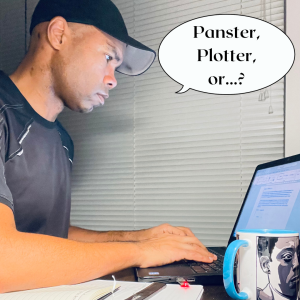
Panster. Plotter. Democrat. Republican. Night owl. Morning person. Vegan. Pescatarian. It’s funny (or maybe not?) how we like to put labels on everything. Maybe it’s because labels let us fit in and feel like we’re part of a group. I’m not saying labels are a bad thing, but maybe our penchant to make sure everyone fits nicely into some box—whatever that box is—is. Growing up, and usually the only Black kid in the class, I certainly didn’t fit in. And I also didn’t belong to any group. Yet I digress…
As I started writing and found my voice, I still didn’t feel like I fitted in because it seemed like my writing didn’t fit squeaky clean into a specific genre. And while a lot of people find a ‘tribe,’ I’m still looking.
And if I had to label my writing style, am I a panster or a plotter? Hmm…
Panster, Plotter, or…?
While a plotter (as the word suggests) plots out their entire story before sitting down to write, a panster writes by the seat of their pants. Writing my first few books, I definitely fell into the panster category. With a vague idea of what I thought the story would be about, I’d sit down and start writing. Then I’d let the characters drive the story, per se. Whatever they did, no matter how crazy, irresponsible, or implausible, ended up on the page. There’s a sense of freedom in that type of writing for me, in that first draft where I can say what I feel without worrying about offending anyone, without the need to filter.
First drafts are, then, verbal diarrhea spewed on the page. No order, no logic. Just complete and utter chaos. But when the first draft is completed, I [usually] know what the story is actually about. Now I’m ready to do the heavy lifting that’s required in the rewrite process.
Panster Pitfalls
As I mentioned earlier, I love the freedom of writing freestyle, of just getting the ideas down. But it does get ‘complicated,’ especially if you rely (like I did for a long time) on your memory to keep all the facts straight. And my memory was good when I was younger, and I didn’t have to worry about a character having green eyes in the first part of the book and suddenly ending up with brown eyes six chapters later.
Thankfully, through the rewriting process, I catch mistakes like that (or my editor does if I miss them). But for a long time, I still couldn’t see myself as a plotter. I’ve tried to imagine what the writing process would look like if I outlined the entire story first. Considering the challenges I’ve faced with staying focused over the past few years, I don’t think I’d even finish the outline, let alone write the book and publish it.
But I’m getting older. My memory falters regularly. And now I find myself somewhere in between pansters and plotters…
The Realm of the Planster
That’s right. I’m a planster. My first drafts are still verbal diarrhea spewed onto the page. But after the first draft is done, I—wait for it!—outline. My outlines are probably not as detailed as a true plotter, but they include a timeline of events. It’s at that point that I create a character log, which includes descriptions of each character, their motivations, and any significant life events that reflect who they are and who they can become. This part of the writing process helps me stay on track and stick to the theme of the story.
For the foreseeable future, I see myself taking on the role of panster with all first drafts. It’s the truest way for me to express myself. It lets me tell the stories I need to hear before they’re crafted into ones for a wider audience.
Maybe I’ve found a tribe, and a label, that suits me after all…
Leave a Reply